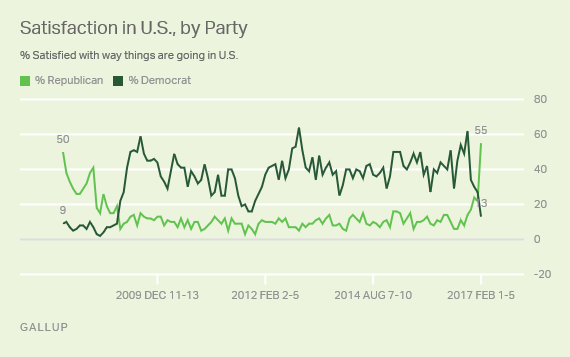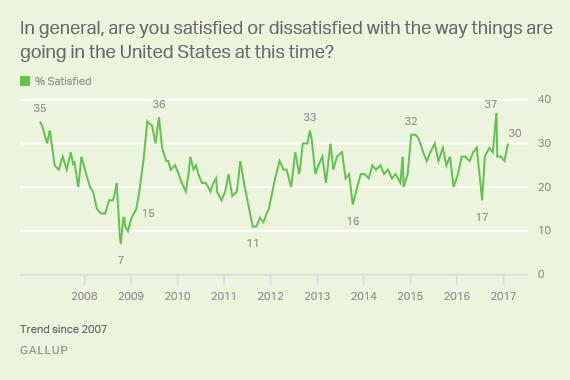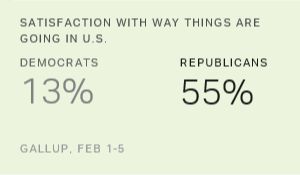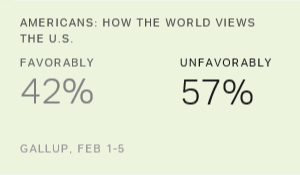Story Highlights
- Overall satisfaction is 30%, up slightly due to GOP surge
- Republicans' satisfaction up 33 percentage points after Trump's inauguration
- Democrats' satisfaction down 14 points
WASHINGTON, D.C. -- A majority of Republicans, 55%, are satisfied with the way things are going in the U.S., up sharply from 22% last month before President Donald Trump's inauguration. Democrats' satisfaction dropped from 27% to 13% in the same period. These shifts resulted in a slight uptick in Americans' overall satisfaction, from 26% to 30%.

As recently as August 2016, as few as 6% of Republicans were satisfied with the way things were going, and the overall 2016 average before Trump's Nov. 8 election stood at 10%. Satisfaction among Republicans began to rise slowly after Trump's victory, from 17% in mid-November to percentages in the lower 20s in December and January before jumping to 55% this month.
On the other side of the political spectrum, 62% of Democrats were satisfied with the way things were going in the U.S. in early November just before the election. This fell sharply to 34% in mid-November and has continued to drop in the following months.
Though the shift in Republicans' response to this question is historically high, the underlying phenomenon is nothing new. Gallup has observed similar realignments in Democrats' and Republicans' satisfaction with how things are going in the country after a president of a new party takes office.
| Republicans | Democrats | ||||||||||||||||||||||||||||||||||||||||||||||||||||||||||||||||||||||||||||||||||||||||||||||||||
|---|---|---|---|---|---|---|---|---|---|---|---|---|---|---|---|---|---|---|---|---|---|---|---|---|---|---|---|---|---|---|---|---|---|---|---|---|---|---|---|---|---|---|---|---|---|---|---|---|---|---|---|---|---|---|---|---|---|---|---|---|---|---|---|---|---|---|---|---|---|---|---|---|---|---|---|---|---|---|---|---|---|---|---|---|---|---|---|---|---|---|---|---|---|---|---|---|---|---|---|
| January | February | Change | January | February | Change | ||||||||||||||||||||||||||||||||||||||||||||||||||||||||||||||||||||||||||||||||||||||||||||||
| 2017 | 22 | 55 | +33 | 27 | 13 | -14 | |||||||||||||||||||||||||||||||||||||||||||||||||||||||||||||||||||||||||||||||||||||||||||||
| 2009 | 19 | 6 | -13 | 9 | 22 | +13 | |||||||||||||||||||||||||||||||||||||||||||||||||||||||||||||||||||||||||||||||||||||||||||||
| 2001 | 58 | 67 | +9 | 59 | 44 | -15 | |||||||||||||||||||||||||||||||||||||||||||||||||||||||||||||||||||||||||||||||||||||||||||||
| 1993 | 43 | 22 | -21 | 17 | 28 | +11 | |||||||||||||||||||||||||||||||||||||||||||||||||||||||||||||||||||||||||||||||||||||||||||||
| Gallup | |||||||||||||||||||||||||||||||||||||||||||||||||||||||||||||||||||||||||||||||||||||||||||||||||||
Democrats' 14-percentage-point drop in satisfaction from January to February is similar to the 15-point decline in Democratic satisfaction in 2001 when Republican George W. Bush replaced Democrat Bill Clinton in the White House. It is also similar to the 13-point decline in Republicans' satisfaction eight years later when power switched to Democrat Barack Obama.
The recent 33-point increase in Republicans' satisfaction, however, is larger than any change in Gallup's trend. The substantial change could be attributable to Trump's unexpected victory, placing the GOP in full control of the executive and legislative branches for the first time since 2006. This allows the GOP to pursue its policy agenda, which was largely thwarted during the Obama administration.
Notably, the current level of satisfaction among Republicans is close to the average GOP satisfaction rate (60%) in 2006, the last year Republicans controlled both the presidency and Congress simultaneously.
Overall Satisfaction Up Slightly to 30%
Overall, 30% of Americans are now satisfied with the way things are going in the U.S., up slightly from 26% last month. The slight uptick reflects the Republican surge and the Democratic decline. Satisfaction has averaged 24% since 2007, with only a few isolated measurements in the 30s, including 37% right before the 2016 presidential election.

Bottom Line
While Trump's inauguration only modestly affected satisfaction levels in the country as a whole, Republicans' and Democrats' satisfaction have changed dramatically. A shift in the relative satisfaction of party groups is consistent with historical patterns, but the degree to which Republicans' satisfaction surged after Trump took office is not.
Still, satisfaction remains below average from a historical perspective, as it has for the last decade. Given Democrats' overwhelming disapproval of Trump, it is likely that satisfaction will remain at the lower levels in the near future.
Historical data are available in Gallup Analytics.
Survey Methods
Results for this Gallup poll are based on telephone interviews conducted Feb. 1-5, 2017, with a random sample of 1,035 adults, aged 18 and older, living in all 50 U.S. states and the District of Columbia. For results based on the total sample of national adults, the margin of sampling error is ±4 percentage points at the 95% confidence level. All reported margins of sampling error include computed design effects for weighting.
Each sample of national adults includes a minimum quota of 70% cellphone respondents and 30% landline respondents, with additional minimum quotas by time zone within region. Landline and cellular telephone numbers are selected using random-digit-dial methods.
View survey methodology, complete question responses and trends.
Learn more about how the Gallup Poll Social Series works.




